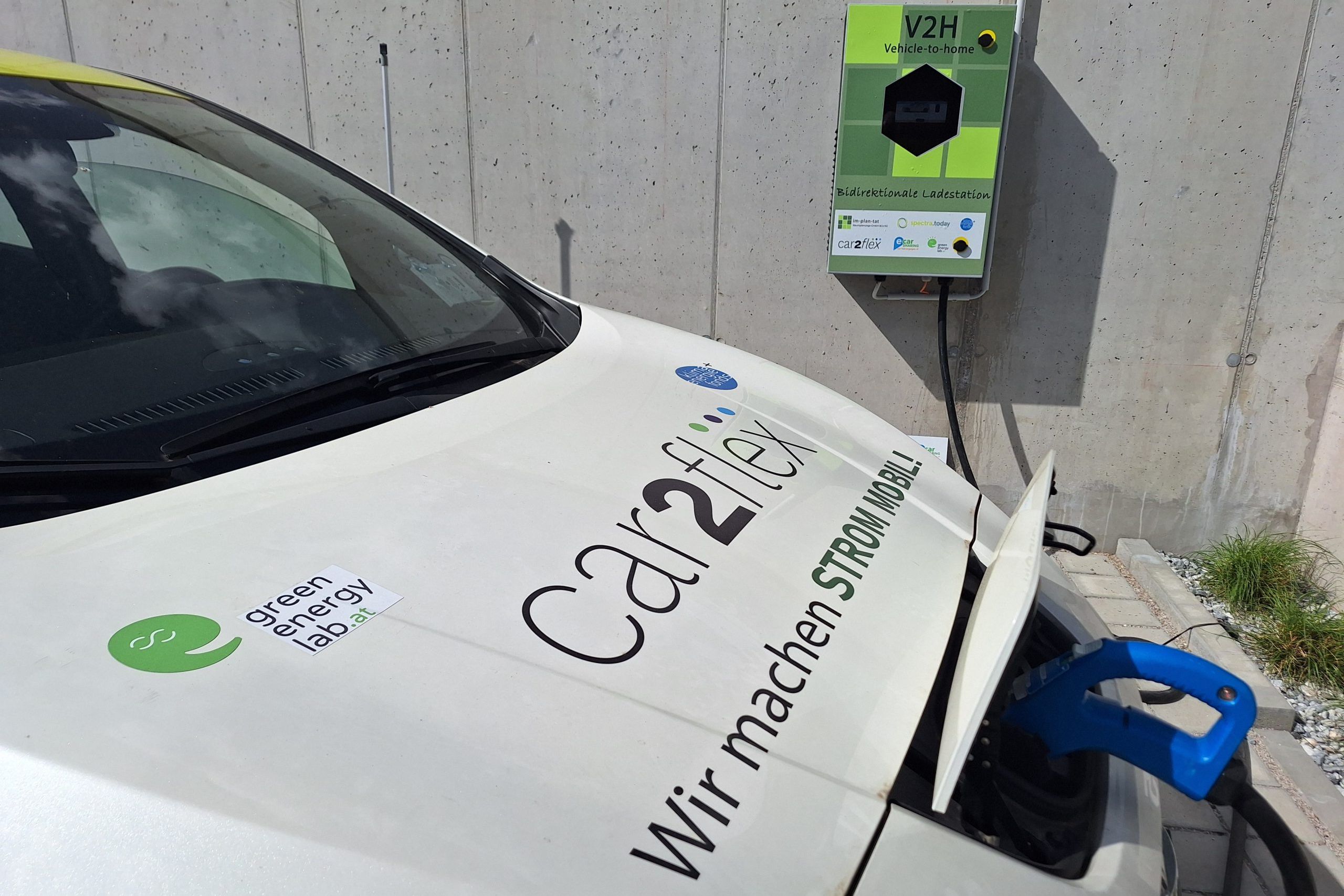Bidirectional charging can support the expansion of renewable energies
A research project at Green Energy Lab is investigating and demonstrating how bidirectional charging of electric vehicles can be implemented. Georg Lettner, Project Manager at TU Wien, Institute of Energy Systems and Electrical Drives, Energy Economics Group (EEG), explains in an interview how bidirectional charging can be used in households with a PV system and could relieve the burden on the electricity grid in the future.

Georg Lettner, Project Manager Car2Flex (© Green Energy Lab / Stephanie Weinhappel)
17 July 2024 – Interview with Georg Lettner, Project Manager at TU Wien:
What is bidirectional electromobility and what advantages could the application bring?
Georg Lettner: Everyone is familiar with conventional e-mobility, which enables driving with electricity from a battery. However, we also want to utilise this storage system, which is installed in the electric car, in other ways. For example, by discharging it at home to cover peak electricity loads. In a home with a photovoltaic system (PV), for example, I can also cover evening or night-time consumption. On the other hand, bidirectional charging also serves to ensure security of supply: In the event of a power outage or a prolonged interruption to the power supply, the house can be supplied with the battery from the electric vehicle. And in everyday life, I can use it to increase self-consumption from my PV system. All of this is summarised under the term “Vehicle-2-Home” applications.
But I can also support the entire electricity system through controlled charging and discharging into the grid – that would be the “Vehicle-2-Grid” approach.

An electric car plugged into a bidirectional charging station © Green Energy Lab
With the Vehicle-2-Home approach, for example, do I have a PV system on the roof and use the electric vehicle as a buffer storage unit?
Yes, exactly. Many households with a PV system have a stationary electricity storage unit for this purpose. I no longer need this, because the car takes over this application when it is at home.
And what is the Vehicle-2-Grid approach in the context of bidirectional charging?
This means I can also feed the electricity from the vehicle battery into the general grid. Sometimes we have too little power generation throughout the day to cover momentary peaks in consumption. This results in short-term bottlenecks on the consumer side. In future, we will be able to use the electricity from the vehicle batteries to compensate for the lack of electricity and will not need to commission large fossil-fuelled power plants.
If you now imagine the enormous dimensions of the electricity grid, then a single electric vehicle will probably not be enough to stabilise the grid, will it?
Exactly, that’s the case. In our project, we are only developing the initial approaches and we will also be testing this at twelve different locations. But in the final stage, many thousands of cars will be needed to effectively implement the Vehicle-2-Grid approach for the electricity system.
And how will these e-cars be bundled accordingly and the charging and discharging controlled? Who should do this, the grid operator, the energy supply company or the vehicle operator itself?
In principle, the control will be carried out by companies that operate the corresponding platforms and also offer energy management. As an end customer, I can then operate and control the energy management of my entire household myself, including the PV system and heat pump management. However, the system has an interface to the grid operator, which sends a corresponding signal in an emergency if there are bottlenecks in the grid. If the user agrees to participate in this system, the battery is automatically charged or discharged and they don’t have to worry about anything else – except that the vehicle has to be plugged in, of course.
This will presumably be fully automated, right? But the user must be able to define a time window in which he wants the car to be fully charged.
Yes, of course you need to know how long the batteries have been connected to the grid and what residual charge level the customer absolutely needs. For the test application as part of the Car2Flex project, there is an app from our platform operator. As a user, I can set when I want to drive away again and what range must still be available in the vehicle at that time. This is ensured by the system. In between, the vehicle battery is either charged or discharged for my own home applications or for the grid.
Why should a vehicle user make their traction battery available to the grid operator? Pure idealism is probably not enough, especially when you think of large fleet operators. What incentives are needed for this?
It is currently still difficult to assess the “prices” of this new “flexibility market” for distribution grid operators. Of course, at least the wear and tear of the battery must be compensated and everyone wants to earn something.
The Car2Flex research project
As part of the Green Energy Lab research initiative, the Car2Flex lead project is looking at bidirectional charging and three different user groups of electric mobility: private users, e-vehicle fleets and e-car sharing in multi-party apartment blocks. The focus is on the question of how – in line with the mobility needs of the respective groups – the increasing share of e-mobility can be ideally integrated into the energy system. With bidirectional charging stations, it is not only possible to charge electricity into the traction batteries, but also to draw power from them again. This means that the car can be used as an intermediate storage unit for private households with PV systems, for example. If the capacities of large e-fleets are bundled, this could also serve to stabilise the power grid. This is explained in the following video:
You are currently seeing a placeholder content of YouTube. To access the actual content, click on the button below. Please note that data will be passed on to third-party providers.
The Car2Flex project is subsidised by the Climate and Energy Fund and implemented in the framework of the RTI Flagship Region Energy initiative.
Contact
Ludwig Fliesser
Communications Manager
T: +43 676 47 19 347
E: ludwig.fliesser@greenenergylab.at
